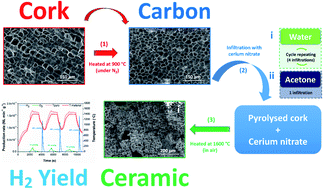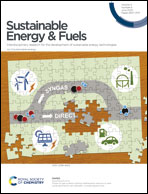High performance cork-templated ceria for solar thermochemical hydrogen production via two-step water-splitting cycles
Abstract
Water splitting by solar energy-driven two-step thermochemical cycles is a promising approach for large-scale production of renewable fuels (e.g. hydrogen). The key challenge is developing materials capable of withstanding the harsh environmental conditions and to ensure high reliability in use, particularly in terms of redox kinetics and better activity at low operation temperatures. In this work, we demonstrate that cork-templated ceria can significantly enhance the hydrogen production performance under solar irradiation heating. Three types of ceria morphologies were synthesised and investigated in two-step thermochemical redox cycles, namely ceria granules (ecoceramics) prepared from cork templates based on either a green water-based or an acetone solvent-based approach, as well as ceria foams replicated from polyurethane templates. These materials were cycled in a high-temperature indirectly-irradiated solar tubular reactor, heated via concentrated solar light, using a temperature-swing process. Samples were typically thermally reduced at 1400–1450 °C and subsequently re-oxidised with H2O between 950–1150 °C. The green synthesis ceria granules had up to 25% and 32% higher average H2 production yields than the acetone-based ecoceramics and replicated ceria foams, respectively. On average, H2 production rates for cork-templated ceria granules (1.3 ± 0.2 mL min−1 g−1) were up to ∼60% higher than for ceria foams (0.8 ± 0.3 mL min−1 g−1), indicating that the morphology of this three-dimensionally ordered macroporous (3-DOM) CeO2 improves the reaction kinetics. This is attributed to the smaller mean cell size of the cork-derived ecoceramic (25 μm) compared to that of the replicated ceria foam (575 μm), suggesting that their semi-closed wall cells enhanced reaction rates. The increase in reduction temperature from 1400 to 1450 °C resulted in the highest H2 production rate (1.6 mL min−1 g−1) reported so far for 3-DOM ceria. Neither loss in redox performance nor change in grain morphology was observed from the first to the last cycle. These findings show that cork-like structural features are key to engineering efficient materials for enhanced solar thermochemical fuel production.



 Please wait while we load your content...
Please wait while we load your content...